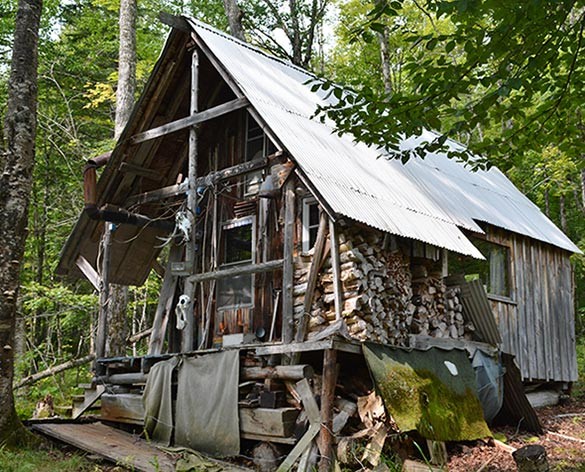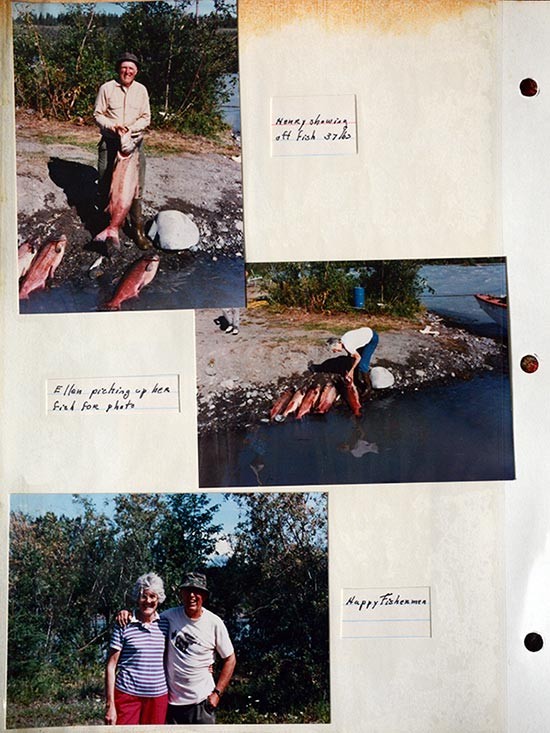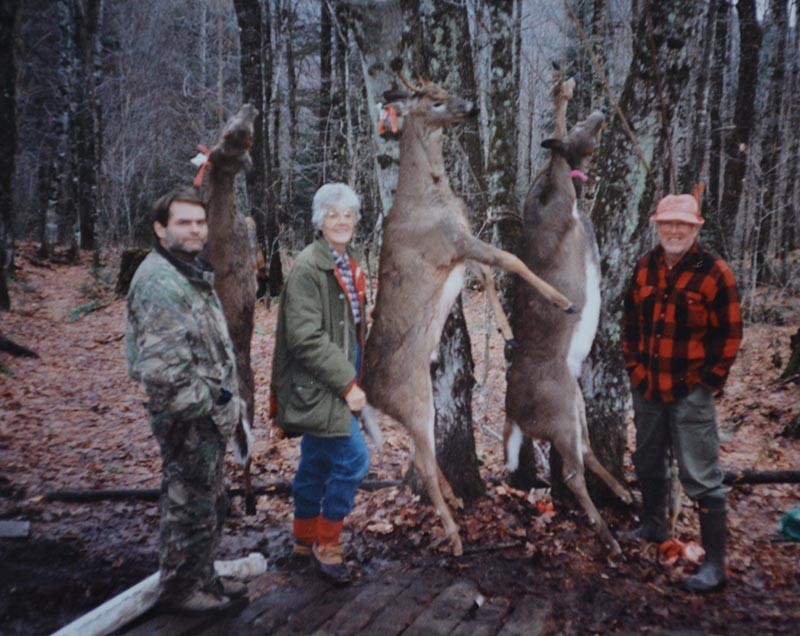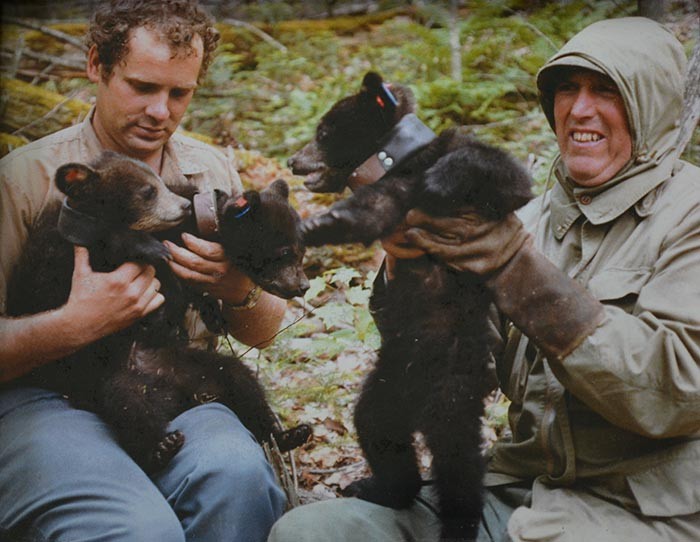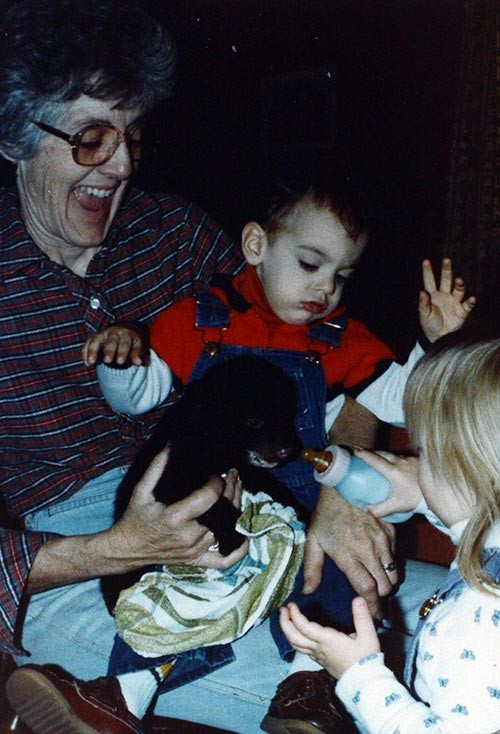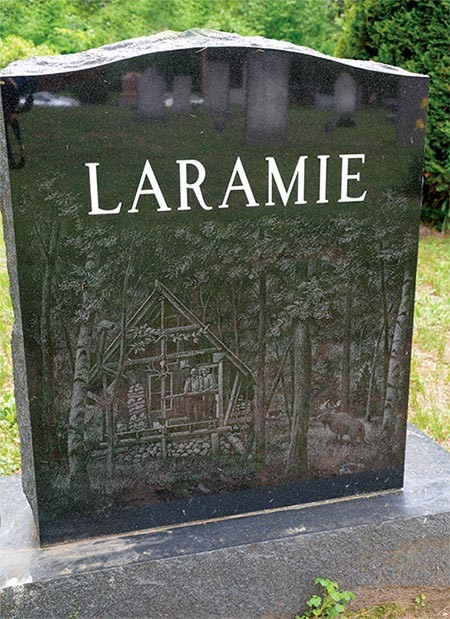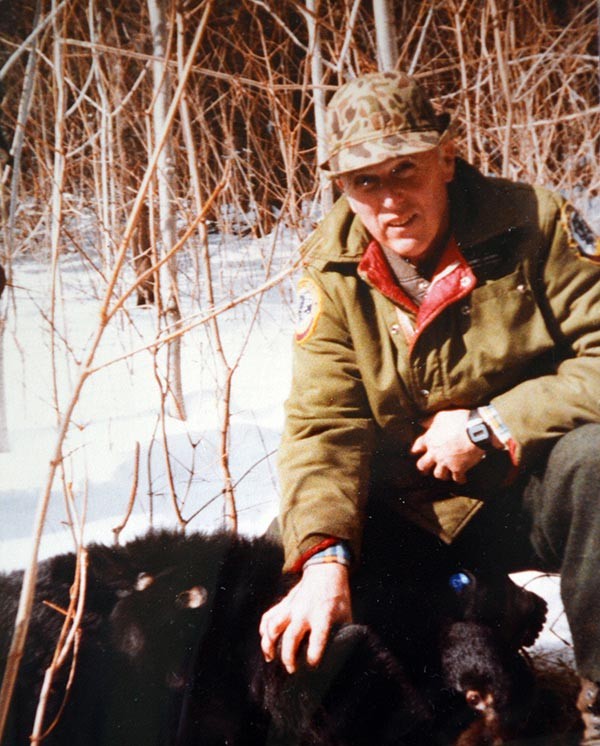I was hiking with friends up a rutted, washed-out logging road in northern New Hampshire when we saw a curious cabin through the trees. A faint footpath led toward the camp, so we wandered over to get a closer look. Clearly nobody had been up this path, nor on the overgrown driveway, in perhaps a few years. And the cabin was – well, unusual is an understatement.
The 1960s-era A-frame had a steep pitched roof, raised porch on the front, and rough board-and-batten siding. There was a hand-built look to it. A wooden sign above the door read, “Smoke Pole Camp.”
The porch was adorned with antlers, rusty antique tools, and jury-rigged lights connected to a couple old car batteries with a tangle of wires. Our curiosity won out over caution as we crept closer, looking for clues about long-ago or recent occupants. The duff on the porch was further indication that the cabin had not been occupied for quite some time. The place had an enchanted, fairytale feel – like it belonged to an ogre, or a hermit under the spell of a woodland wizard.
We climbed the rickety steps onto the quaking porch to peer in the window. A rusty but sturdy steel bar and padlock secured the front door. Inside was a single room. We could see an unmade bed, dishes on the counter near the sink, and a flashlight, papers, and a pair of scissors scattered on a Formica table surrounded by matching sky-blue chairs. The only signs of life (so to speak) were two dead mice on the carpet.
It looked like someone had left one day, intending to return, and had never come back. It was a moment frozen in time.
Going around back, we discovered a grim gallery of eight moose skulls and toothy jawbones carefully mounted on the back wall. The hollow eyes watched us as we circled around to the front. A dozen paces to our left was an active moose wallow oozing mud that showed clear prints all around. Obviously, moose had been frequenting this area more recently than the camp’s owner. The mystery of Smoke Pole Camp stayed with us as we headed back to the road.
A few hundred yards down the road, we met some local people who told us the camp belonged to Henry Laramie, a local legend who had worked as a moose and bear biologist for the New Hampshire Fish and Game Department for many years. They mentioned that Henry had died several years earlier, but they were not sure if anyone was still using the camp.
I decided to do a little research when I got home. It turns out that Henry Laramie was born in Enfield, New Hampshire, in 1926 and earned a forestry and wildlife degree at UNH. After a short stint as a tail gunner in the Army Air Corps, he became a biologist for the state, where he worked for more than 30 years. Over his career he became an influential national leader in the advent of scientific wildlife management.
The more I learned about Henry, the more interested I became. I was fortunate to be able to meet with his youngest daughter, Sally, who showed me old family photos. And several former colleagues and contemporaries were generous enough to share some stories about Henry and his impressive accomplishments.
Monitoring the Moose
At the turn of the twentieth century, there were almost no moose left in New Hampshire. And the state’s mighty forests were a fraction of what they were – and are again today. The landscape was dominated by sheep farming and other agriculture.
As the farms gave way to regenerating forests over the next 50 years, the moose population in New Hampshire grew slowly to a few hundred animals by the time Henry started his career. Young Henry Laramie began documenting the moose population across the state to understand the distribution and impact of the moose herd on the landscape.
He instituted a system of “sighting cards” for citizens to report moose encounters. He personally tracked, mapped, and counted moose across the state. “He did a lot of walking in that country,” observed Bing Judd, a former New Hampshire Fish and Game Department commissioner.
Using the data he collected, Henry advocated for the first moose hunt in 1978 as a way to control the population in areas where it was in danger of exceeding the habitat capacity. Henry also hired the state’s first moose biologist to monitor the population relative to the annual kill from hunting and other causes.
Concerned that the growing moose population was becoming a danger to drivers, especially when the animals congregated to lick salt along the roadsides, Henry proposed putting salt licks deep in the woods. No one thought it would work. So he tried it near his camp and was able to document the results on film. The idea never really caught on, but the moose wallow remains near his camp.
The moose population continued to grow until peaking in the late 1990s at roughly 7,500 animals. New Hampshire has about 4,000 moose today, which explains why we see them less often than we did a decade or two ago. According to the National Wildlife Federation, biologists attribute some of this relatively recent decline to increasing parasite loads resulting from shorter winters.
Beaver Deceiver
It wasn’t just moose that Henry focused on. Until he came along, beavers were generally considered a nuisance and were routinely killed when their dams created problems. In 1963, Henry published a paper in The Journal of Wildlife Management (Vol. 27, No. 3) titled, “A Device for Control of Problem Beavers;” this fencing system to prevent the damming of culverts eventually became known as The Beaver Deceiver.
Based on the data he presented, Henry’s improved design became for many years the standard for controlling the water level of beaver ponds to prevent roads or pastures from flooding without having to remove the beavers.
Henry’s tinkering and publication led to a strong rebound in the beaver populations across the state – and across the continent as other wildlife departments adopted Henry’s design. Indirectly, the Beaver Deceiver also helped moose, waterfowl, and other wildlife that benefit from bogs and wetland vegetation.
The Great Turkey Trade
John Harrigan, who for more than four decades wrote an outdoor column in the New Hampshire Sunday News, covered Henry’s work at the New Hampshire Fish and Game Department for many years. “Henry Laramie was a hardheaded SOB,” said Harrigan. “I had great respect for him. He understood the woods. He believed in the public trust. And he had a hell of an impact on the wildlife in this state.”
Harrigan told me he was on-site with Henry for The Great Turkey Trade. In 1969, Henry live-trapped 23 fishers (some accounts say 31) in New Hampshire and traded them for 25 live wild turkeys from the state of West Virginia. The turkeys were released at Pawtuckaway State Park in southeast New Hampshire. Unfortunately, the small flock from down south could not survive heavy predation and two successive tough winters. In West Virginia, the fisher reintroduction was more successful. The population soon expanded its range into Maryland.
But New Hampshire didn’t give up on the turkeys. In 1975, the state released another flock near Keene, which was successful. As the flock grew, biologist Ted Walski netted the big birds and relocated flocks to new habitats across the state, resulting in their widespread abundance today.
Respect for Black Bears
When Henry began his career at the New Hampshire Fish and Game Department, there was still a bounty on black bears, considered at the time to be a nuisance to agriculture and a danger to humans. He pressed the department and the legislature to lift the bounty and to impose the first restrictions on hunting black bears. Throughout his career, Henry was dogged in making the public understand the critical role that wildlife plays in the overall ecosystem and the importance of studying each species and their population dynamics. “Henry really loved the wildlife in our state. He wanted to protect and respect all species,” John Harrigan observed about his friend.
Instead of killing nuisance bears, Henry began trapping, tagging, and relocating them to study their behavior in the 1960s and 1970s. In 1979, Henry hired Eric Orff to be the state’s first bear biologist; Orff was a protégé of Henry and a member of the New Hampshire Fish and Game Commission. Together they studied bear populations and reproduction rates in each county, crawling into dens to tranquilize and tag or radio-collar sows and cubs. Orff recounted how Henry worked with Concord veterinarian James Paine to determine the proper drug and dosage to safely tranquilize a full-grown bear.
They relocated problem bears, including one memorable bear that was up a tree on the Plymouth State College campus. In 1983, the black bear was removed from the nuisance list and designated a “game animal,” with a hunting season set by the state legislature.
The published proceedings of the 1984 Eastern Black Bear Management Conference showed how Henry, true to form, used a data-driven approach in determining management strategies. He kept detailed records and sliced the data in creative ways to understand the population and test his theories.
At the 1984 conference, he described a study to determine the effect on cubs of hunters training their dogs to chase bears during the summer. After attaching a radio collar to a sow with three cubs, he tracked the family through the summer when they were chased by hunting dogs.
“There was no doubt in my mind that this sow could count to three and that she knew exactly where she left each one of her cubs,” Henry wrote. “If anyone else has similar data, we would appreciate access to it for a sample of one is not very conclusive.” His report ended with a similar plea for more data on black bear reproduction: age, frequency of birth, and annual production by age class. Henry wanted to base his decisions on hard data whenever he could.
Protecting and Parenting Many Creatures
The timber rattlesnake is listed as very rare and endangered in New Hampshire. Its habitat is “critically imperiled,” with only one breeding colony known to exist in the state. Henry Laramie kept the rattler den’s location secret for many years. When there were no sightings for long periods, he would worry the colony might have been wiped out. Orff told me that two weeks before Henry’s death in 2002, while very ill with cancer, he was cheered up by the news that a timber rattler had been sighted, confirming the rare species was still hanging on.
Henry’s daughter Sally recalled a childhood filled with animals brought back to the house for nursing and rehabilitation. Henry and his wife, Ellen, were foster parents to many orphaned or injured animals at their home in Pembroke. Sally remembers that her parents raised a baby beaver named Snuffles, feeding it with a bottle and letting it swim in the sink. When he grew larger, Snuffles would go out to swim in the pond and gnaw on the door frame to ask to come back into the house.
They also raised four bear cubs in the house over the years, including one juvenile weighing over 100 pounds that frightened Ellen when it escaped the basement and she found it under the kitchen table having a stolen snack.
One year, Henry was trying to rehabilitate an injured bobcat when it bit through his thumb. Rather than kill the bobcat to test it for rabies, Henry opted to take the full course of rabies shots. Henry felt the bobcat was justified in defending itself, even though he suffered permanent damage to his thumb. After his retirement, Henry also strongly opposed a proposal to allow bobcat hunting and worked hard to defeat it.
Active After Retirement
“After he retired, Henry would come to the New Hampshire Fish and Game Commission meetings and sit in the front row, picking us apart,” recalled Bing Judd. “He was a character. He worked hard and knew what the data were telling him. He always had something to say about whether the number of permits should go up or down. Henry spoke his mind.”
Kent Gustafson, who now is wildlife program supervisor with the state’s Fish and Game Department, noted that, “long after he retired, Henry would come into the office and tell us what we were doing wrong. And often, he was right. This was part of his character.”
Bill Pepin, Henry’s son-in-law, went up to Henry’s camp with him for over 20 years. They hunted deer (neither ever drew a moose permit), tracked moose, and collected the skulls and old tools which now adorn the camp’s walls. According to Pepin, Henry loved hunting with a muzzleloader, nicknamed a “smoke pole,” hence the name of his camp. When Henry’s health was failing during a long battle with cancer, Bill brought him up to his beloved camp as often as he could.
Henry died in 2002. Nine years later, Eric Orff lobbied for and succeeded in getting a bill introduced to the state legislature that renamed the 3,000-acre Enfield Wildlife Management Area the Henry Laramie Wildlife Management Area.
“Henry had his own way of defending those that couldn’t defend themselves,” Orff told me. “The wildlife couldn’t speak, so Henry spoke for them.”
After Henry’s death, his wife Ellen continued to go up to the camp for many years with family members. About three years ago, her health started failing, and she could no longer go to the camp. So it sat, unused, until Bill Pepin purchased it in the fall of 2015, a few months before Ellen passed away and around the time that I stumbled upon it.
Pepin is now renovating the Smoke Pole Camp, but plans to keep the quirky exterior as is. “Henry loved being at his camp. It was a big part of his life. And for Henry, wildlife came first.”


